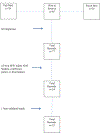Autonomic nervous system functioning assessed during the Still-Face Paradigm: A meta-analysis and systematic review of methods, approach and findings
- PMID: 33707809
- PMCID: PMC7945875
- DOI: 10.1016/j.dr.2018.06.002
Autonomic nervous system functioning assessed during the Still-Face Paradigm: A meta-analysis and systematic review of methods, approach and findings
Abstract
Animal and human research suggests that the development of the autonomic nervous system (ANS) is particularly sensitive to early parenting experiences. The Still-Face Paradigm (SFP), one of the most widely used measures to assess infant reactivity and emotional competence, evokes infant self-regulatory responses to parental interaction and disengagement. This systematic review of 33 peer-reviewed studies identifies patterns of parasympathetic (PNS) and sympathetic (SNS) nervous system activity demonstrated by infants under one year of age during the SFP and describes findings within the context of sample demographic characteristics, study methodologies, and analyses conducted. A meta-analysis of a subset of 14 studies with sufficient available respiratory sinus arrhythmia (RSA) data examined whether the SFP reliably elicited PNS withdrawal (RSA decrease) during parental disengagement or PNS recovery (RSA increase) during reunion, and whether results differed by socioeconomic status (SES). Across SES, the meta-analysis confirmed that RSA decreased during the still-face episode and increased during reunion. When studies were stratified by SES, low-SES or high-risk groups also showed RSA decreases during the still face episode but failed to show an increase in RSA during reunion. Few studies have examined SNS activity during the SFP to date, preventing conclusions in that domain. The review also identified multiple qualifications to patterns of SFP ANS findings, including those that differed by ethnicity, infant sex, parental sensitivity, and genetics. Strengths and weaknesses in the extant research that may explain some of the variation in findings across the literature are also discussed, and suggestions for strengthening future research are provided.
Keywords: Autonomic Nervous System; Meta-analysis; Respiratory Sinus Arrhythmia; Still-Face Paradigm; Systematic Review.
Figures
Similar articles
-
Infant physiological response to the still-face paradigm: contributions of maternal sensitivity and infants' early regulatory behavior.Infant Behav Dev. 2010 Jun;33(3):251-65. doi: 10.1016/j.infbeh.2010.01.001. Epub 2010 Mar 6. Infant Behav Dev. 2010. PMID: 20207419
-
Polymorphic variation in the SLC5A7 gene influences infant autonomic reactivity and self-regulation: A neurobiological model for ANS stress responsivity and infant temperament.Psychoneuroendocrinology. 2018 Nov;97:28-36. doi: 10.1016/j.psyneuen.2018.06.019. Epub 2018 Jun 25. Psychoneuroendocrinology. 2018. PMID: 30005279 Free PMC article.
-
Parental sensitivity modifies the associations between maternal prenatal stress exposure, autonomic nervous system functioning and infant temperament in a diverse, low-income sample.Attach Hum Dev. 2023 Oct;25(5):487-523. doi: 10.1080/14616734.2023.2257669. Epub 2023 Nov 7. Attach Hum Dev. 2023. PMID: 37749913
-
Restricted repetitive behaviors in autism spectrum disorder: A systematic review from the neurovisceral integration perspective.Biol Psychol. 2019 Nov;148:107739. doi: 10.1016/j.biopsycho.2019.107739. Epub 2019 Aug 12. Biol Psychol. 2019. PMID: 31415791
-
Respiratory sinus arrhythmia reactivity across empirically based structural dimensions of psychopathology: A meta-analysis.Psychophysiology. 2019 May;56(5):e13329. doi: 10.1111/psyp.13329. Epub 2019 Jan 23. Psychophysiology. 2019. PMID: 30672603 Free PMC article. Review.
Cited by
-
Pregnant women's autonomic responses to an infant cry predict young infants' behavioral avoidance during the still-face paradigm.Dev Psychol. 2023 Dec;59(12):2237-2247. doi: 10.1037/dev0001632. Epub 2023 Sep 28. Dev Psychol. 2023. PMID: 37768605 Free PMC article.
-
Maternal Sensitivity as a Predictor of Change in Respiratory Sinus Arrhythmia Activity From Infancy to Toddlerhood.Infant Child Dev. 2024 Nov-Dec;33(6):e2545. doi: 10.1002/icd.2545. Epub 2024 Oct 1. Infant Child Dev. 2024. PMID: 40248046
-
Preliminary Technical Validation of LittleBeats™: A Multimodal Sensing Platform to Capture Cardiac Physiology, Motion, and Vocalizations.Sensors (Basel). 2024 Jan 30;24(3):901. doi: 10.3390/s24030901. Sensors (Basel). 2024. PMID: 38339617 Free PMC article.
-
Physiological measurement of emotion from infancy to preschool: A systematic review and meta-analysis.Brain Behav. 2021 Feb;11(2):e01989. doi: 10.1002/brb3.1989. Epub 2020 Dec 17. Brain Behav. 2021. PMID: 33336555 Free PMC article.
-
Latent Profiles of Infant Negative Affect and RSA During the Still-Face Paradigm: The Role of Maternal Sensitivity.Infant Child Dev. 2024 Nov-Dec;33(6):e2532. doi: 10.1002/icd.2532. Epub 2024 Jul 9. Infant Child Dev. 2024. PMID: 40017999 No abstract available.
References
-
- Adamson LB, & Frisk JE (2003). The Still Face: A history of a shared experimental paradigm. Infancy, 4(4), 451–473.
-
- Ainsworth MDS, Blehar MC, Waters E, & Wall S (1978). Patterns of attachment: A psychological study of the strange situation. (Erlbaum. Ed.). Hillsdale, NJ.



